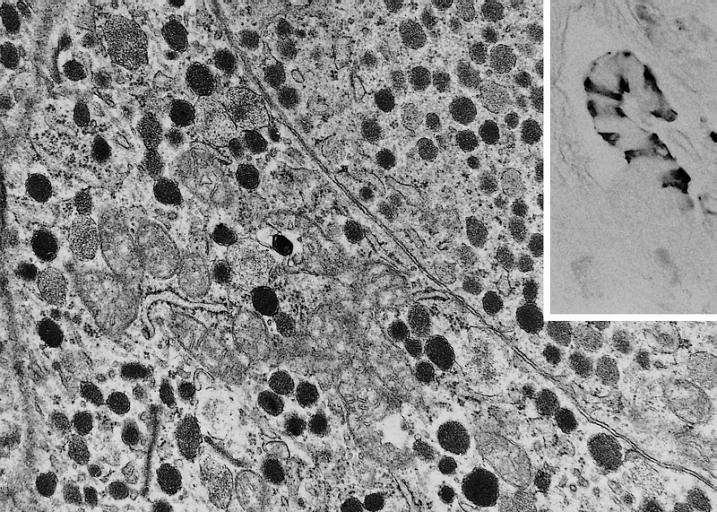VIPoma: Difference between revisions
m (Robot: Automated text replacement (-{{SIB}} +, -{{EH}} +, -{{EJ}} +, -{{Editor Help}} +, -{{Editor Join}} +)) |
Homa Najafi (talk | contribs) No edit summary |
||
| (18 intermediate revisions by 8 users not shown) | |||
| Line 1: | Line 1: | ||
__NOTOC__ | |||
{{Infobox_Disease | | {{Infobox_Disease | | ||
Name = VIPoma | | Name = VIPoma | | ||
Image = Pancreatic vipoma.jpg| | Image = Pancreatic vipoma.jpg| | ||
Caption = Pancreatic vipoma. Electron microscopy of a pancreatic VIPoma. Abundant secretory granules of variable size, shape, and density in a pancreatic tumor with WDHA syndrome. Abundant PP-and a few VIP-immunoreactive cells (inset) were detected by light microscopic immunohistochemistry of the same tumor (X28.000). <br> <small> [http://www.peir.net Image courtesy of Professor Peter Anderson DVM PhD and published with permission © PEIR, University of Alabama at Birmingham, Department of Pathology] </small>| | Caption = Pancreatic vipoma. Electron microscopy of a pancreatic VIPoma. Abundant secretory granules of variable size, shape, and density in a pancreatic tumor with WDHA syndrome. Abundant PP-and a few VIP-immunoreactive cells (inset) were detected by light microscopic immunohistochemistry of the same tumor (X28.000). <br> <small> [http://www.peir.net Image courtesy of Professor Peter Anderson DVM PhD and published with permission © PEIR, University of Alabama at Birmingham, Department of Pathology] </small>| | ||
}} | }} | ||
{{ | '''For patient information, click [[VIPoma (patient information)|here]]''' | ||
{{CMG}} | {{VIPoma}} | ||
{{CMG}}; {{AE}}{{Homa}}{{MSI}} {{PSD}} | |||
{{SK}} [[VIPomas]][[Watery diarrhea with hypokalemic alkalosis|; watery diarrhea with hypokalemic alkalosis]]; [[WDHA syndrome]]; [[watery diarrhea hypokalemia achlorhydria syndrome]]; [[pancreatic cholera syndrome]]; [[Verner-Morrison syndrome|Verner-Morrison syndrome;]] [[non-beta pancreatic islet cell tumor]]; [[diarrheogenic islet cell tumor]]; [[VIP-secreting tumor]]; [[vasoactive intestinal polypeptide secreting tumor]], [[pancreatic VIPoma]] | |||
==[[VIPoma overview|Overview]]== | |||
==[[VIPoma historical perspective|Historical Perspective]]== | |||
== | ==[[VIPoma pathophysiology|Pathophysiology]]== | ||
==[[VIPoma causes|Causes]]== | |||
==[[VIPoma differential diagnosis|Differentiating VIPoma from other Diseases]]== | |||
==[[VIPoma epidemiology and demographics|Epidemiology and Demographics]]== | |||
== | ==[[VIPoma risk factors|Risk Factors]]== | ||
== | ==[[VIPoma screening|Screening]]== | ||
== | ==[[VIPoma natural history, complications and prognosis|Natural History, Complications and Prognosis]]== | ||
== | ==Diagnosis== | ||
[[VIPoma history and symptoms|History and Symptoms]] | [[VIPoma physical examination|Physical Examination]] | [[VIPoma laboratory findings|Laboratory Findings]] | [[VIPoma x ray|X Ray]] | [[VIPoma CT|CT]] | [[VIPoma MRI|MRI]] | [[VIPoma echocardiography or ultrasound|Echocardiography or Ultrasound]] | [[VIPoma other imaging findings|Other Imaging Findings]] | | |||
[[VIPoma other diagnostic studies|Other Diagnostic Studies]] | |||
==Treatment== | |||
[[VIPoma medical therapy|Medical Therapy]] | [[VIPoma surgery|Surgery]] | [[VIPoma primary prevention|Primary Prevention]] | [[VIPoma secondary prevention|Secondary Prevention]] | [[VIPoma cost-effectiveness of therapy|Cost-Effectiveness of Therapy]] | [[VIPoma future or investigational therapies|Future or Investigational Therapies]] | |||
==Case Studies== | |||
[[ | [[VIPoma case study one|Case #1]] | ||
{{WikiDoc Help Menu}} | {{WikiDoc Help Menu}} | ||
{{WikiDoc Sources}} | {{WikiDoc Sources}} | ||
[[Category:Medicine]] | |||
[[Category:Oncology]] | |||
[[Category:Up-To-Date]] | |||
[[Category:Endocrinology]] | |||
[[Category:Gastroenterology]] | |||
Latest revision as of 18:07, 23 September 2023
| VIPoma | |
 | |
|---|---|
| Pancreatic vipoma. Electron microscopy of a pancreatic VIPoma. Abundant secretory granules of variable size, shape, and density in a pancreatic tumor with WDHA syndrome. Abundant PP-and a few VIP-immunoreactive cells (inset) were detected by light microscopic immunohistochemistry of the same tumor (X28.000). Image courtesy of Professor Peter Anderson DVM PhD and published with permission © PEIR, University of Alabama at Birmingham, Department of Pathology |
For patient information, click here
|
VIPoma Microchapters |
|
Diagnosis |
|---|
|
Treatment |
|
Case Studies |
|
VIPoma On the Web |
|
American Roentgen Ray Society Images of VIPoma |
Editor-In-Chief: C. Michael Gibson, M.S., M.D. [1]; Associate Editor(s)-in-Chief: Homa Najafi, M.D.[2]Madhu Sigdel M.B.B.S.[3] Parminder Dhingra, M.D. [4]
Synonyms and keywords: VIPomas; watery diarrhea with hypokalemic alkalosis; WDHA syndrome; watery diarrhea hypokalemia achlorhydria syndrome; pancreatic cholera syndrome; Verner-Morrison syndrome; non-beta pancreatic islet cell tumor; diarrheogenic islet cell tumor; VIP-secreting tumor; vasoactive intestinal polypeptide secreting tumor, pancreatic VIPoma
Overview
Historical Perspective
Pathophysiology
Causes
Differentiating VIPoma from other Diseases
Epidemiology and Demographics
Risk Factors
Screening
Natural History, Complications and Prognosis
Diagnosis
History and Symptoms | Physical Examination | Laboratory Findings | X Ray | CT | MRI | Echocardiography or Ultrasound | Other Imaging Findings | Other Diagnostic Studies
Treatment
Medical Therapy | Surgery | Primary Prevention | Secondary Prevention | Cost-Effectiveness of Therapy | Future or Investigational Therapies
Case Studies